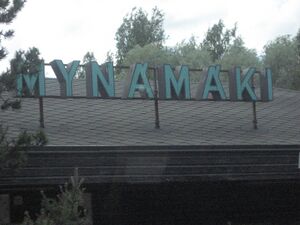Ä
الحرف Ä (أو ä) هي أحد الحروف الإضافية في الأبجدية اللاتينية. وهو عبارة عن حرف A وفوقه نقطتين مصفوفتين ضمن العديد من الأبجديات اللاتينية. في الأبجدية الصوتية الدولية، فإنه يمثل open central unrounded vowel.
الإستخدامات
The letter Ä occurs as an independent letter in the Finnish, Swedish, Skolt Sami, Karelian, Estonian, Luxembourgish, North Frisian, Saterlandic, Emilian, Rotuman, Slovak, Tatar, Kazakh, Gagauz, German, and Turkmen alphabets, where it represents a vowel sound. In Finnish, Kazakh, Turkmen and Tatar, this is always [æ]; in Swedish and Estonian, regional variation, as well as the letter's position in a word, allows for either [æ] or [ɛ]. In German and Slovak Ä stands for [ɛ] (or the archaic but correct [æ]). In the romanization of Nanjing Mandarin, Ä stands for [ɛ].

In the Nordic countries, the vowel sound [æ] was originally written as "Æ" when Christianisation caused the former Vikings to start using the Latin alphabet around A.D. 1100. The letter Ä arose in German and later in Swedish from originally writing the E in AE on top of the A, which with time became simplified as two dots, consistent with the Sütterlin script. In the Icelandic, Faroese, Danish and Norwegian alphabets, "Æ" is still used instead of Ä.
Finnish adopted the Swedish alphabet during the 700 years that Finland was part of Sweden. Although the idea of the Germanic umlaut does not exist in Finnish, the phoneme /æ/ does. Estonian gained the letter through extensive exposure to German, with Low German throughout centuries of effective Baltic German rule, and to Swedish, during the 160 years of Estonia as a part of the Swedish Empire until 1721.
The letter is also used in some Romani alphabets.
Emilian
In Emilian ä is used to represent [æ], occurring in some dialects, e.g. Bolognese bän [bæŋ] "good, well" and żänt [zæŋt] "people".
Kazakh
Under Kassym-Jomart Tokayev's suggestions to modify the Kazakh Latin alphabet, it will represent the IPA /æ/, and the Cyrillic Ә is to be replaced by this letter, the replacement letter was Á in the 2018 proposal.
Cyrillic
Ӓ is used in some alphabets invented in the 19th century which are based on the Cyrillic script. These include Mari, Altay[بحاجة لمصدر] and the Keräşen Tatar alphabet.
Umlaut-A

A similar glyph, A with umlaut, appears in the German alphabet. It represents the umlauted form of a [aː] ([a] when short), resulting in [ɛː] (or [eː] for many speakers) in the case of the long [aː] and [ɛ] in the case of the short [a]. In German, it is called Ä (pronounced [ɛː]) or Umlaut-A. Referring to the glyph as A-Umlaut is an uncommon practice, and would be ambiguous, as that term also refers to Germanic a-mutation. The digraph ⟨äu⟩ is used for the fronting diphthong [ɔʏ] (otherwise spelled with ⟨eu⟩) when it acts as the umlauted form of the backing diphthong [aʊ] (spelled ⟨au⟩); compare Baum [ˈbaʊm] 'tree' with Bäume [ˈbɔʏmə] 'trees'. In German dictionaries, the letter is collated together with A, while in German phonebooks the letter is collated as AE. The letter also occurs in some languages which have adopted German names or spellings, but is not a part of these languages' alphabets. It has recently been introduced in revivalist Ulster-Scots writing.
The letter was originally an A with a lowercase e on top, which was later stylized to two dots.
In other languages that do not have the letter as part of the regular alphabet or in limited character sets such as US-ASCII, Ä is frequently replaced with the two-letter combination "Ae".
Phonetic alphabets
- In the International Phonetic Alphabet, ä represents an open central unrounded vowel (in distinction to an open front unrounded vowel).
- in the Rheinische Dokumenta, a phonetic alphabet for many West Central German, Low Rhenish, and a few related languages, "ä" represents the sound [ɛ].
Typography

Historically A-diaeresis was written as an A with two dots above the letter. A-umlaut was written as an A with a small e written above (Aͤ aͤ): this minute e degenerated to two vertical bars in medieval handwriting (A̎ a̎). In most later handwritings these bars in turn nearly became dots.
Æ, a highly similar ligature evolving from the same origin as Ä, evolved in the Icelandic, Danish and Norwegian alphabets. The Æ ligature was also common in Old English, but had largely disappeared in Middle English.
In modern typography there was insufficient space on typewriters and later computer keyboards to allow for both A-diaeresis (also representing Ä) and A-umlaut. Since they looked near-identical the two glyphs were combined, which was also done in computer character encodings such as ISO 8859-1. As a result, there was no way to differentiate between the different characters. Unicode theoretically provides a solution, but recommends it only for highly specialized applications.[1]
Ä is also used to represent the ə (the schwa sign) in situations where the glyph is unavailable, as used in the Tatar and Azeri languages. Turkmen started to use Ä officially instead of the schwa from 1993 onwards.
Computer encoding
| الحرف | Ä | ä | ||
|---|---|---|---|---|
| Unicode name | LATIN CAPITAL LETTER A WITH DIAERESIS | LATIN SMALL LETTER A WITH DIAERESIS | ||
| Encodings | decimal | hex | decimal | hex |
| يونيكود | 196 | U+00C4 | 228 | U+00E4 |
| UTF-8 | 195 132 | C3 84 | 195 164 | C3 A4 |
| Numeric character reference | Ä | Ä | ä | ä |
| Named character reference | Ä | ä | ||
| EBCDIC family | 99 | 63 | 67 | 43 |
| ISO 8859-1/2/3/4/9/10/13/14/15/16 | 196 | C4 | 228 | E4 |
| MS-DOS alt code | alt+142 | alt+132 | ||
المصادر
- ^ Unicode FAQ Characters and Combining Marks – "Unicode doesn't seem to distinguish between trema and umlaut, but I need to distinguish. What shall I do?"
External links
- Short description matches Wikidata
- Articles with hatnote templates targeting a nonexistent page
- Articles containing إميلية-language text
- Articles with unsourced statements from June 2008
- Articles containing ألمانية-language text
- Specific letter-diacritic combinations
- Vowel letters
- Latin alphabet ligatures
- حروف لاتينية غير المألوف
- حروف لاتينية
